
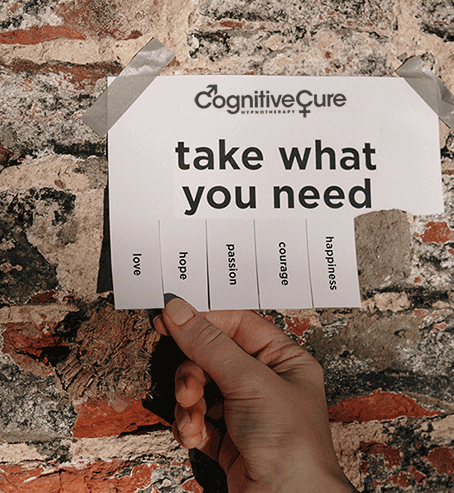
TAKEDOWN ON TRAUMA
Trauma can be a silent force that shapes our lives in countless ways, often manifesting in unexpected and challenging forms. From anxiety and depression to physical ailments and self-destructive habits, its impact knows no bounds. But here’s the silver lining: hypnotherapy can be the key to unlock healing and transformation. By delving into the subconscious mind, it empowers individuals to confront their trauma, rewire negative patterns, and discover newfound resilience. With each session, clients can embark on a journey of self-discovery and emerge stronger, more empowered, and ready to embrace life’s limitless possibilities. Trauma may be complex, but so is the power of hypnotherapy to overcome it.

THE FEAR FACTOR
Overcoming phobias with hypnotherapy is a fascinating and effective approach to addressing irrational fears and anxieties that can significantly hinder one’s quality of life. Phobias are often deeply rooted in the subconscious mind, triggered by past experiences or events. Hypnotherapy, as a therapeutic tool, delves into the subconscious to reframe and reshape the way an individual perceives and responds to their fear triggers.
During hypnotherapy sessions aimed at phobia treatment, a trained hypnotherapist guides the client into a deeply relaxed and suggestible state. In this altered state of consciousness, individuals can access their subconscious mind more readily and safely confront the source of their phobia. Through carefully crafted suggestions and visualization techniques, the therapist can help the client rewire their thought patterns and emotional responses, gradually reducing the intensity of the fear. Over time, this can lead to a remarkable shift in how the individual perceives and reacts to their phobia, allowing them to regain control and reclaim a life free from the limitations of irrational fear.
What makes hypnotherapy particularly effective in treating phobias is its ability to target the root cause of the fear, not just mask the symptoms. By uncovering and addressing the underlying beliefs or traumatic experiences that fuel the phobia, individuals can experience lasting relief and empowerment. Hypnotherapy offers a path to not only manage phobias but also to conquer them, enabling individuals to live a more fulfilled and fearless life. However, it’s crucial to seek a qualified and experienced hypnotherapist for such treatments to ensure safety and effectiveness.

SOUNDS FAMILIAR
Have you ever found yourself entranced by the soothing tones of a radio host’s voice, hanging on to every word they utter? Just like that captivating voice on the airwaves, the role of voice in hypnosis holds a similar allure, but with a profound purpose. The journey into the world of hypnosis unveils the remarkable influence the human voice can wield over our thoughts, feelings, and behaviors. More than just a tool of communication, the voice becomes a bridge to the subconscious, a pathway to change, and a key to unlocking the potential of our minds.
When you listen to a captivating voice on the radio, you’re drawn in by the unique cadence, rhythm, and resonance that captivate your attention. Similarly, in the realm of hypnosis, a skilled hypnotist uses their voice as an instrument to guide their subjects into a state of deep relaxation and heightened suggestibility. The nuances of tone, pace, and modulation become the threads that weave the fabric of a hypnotic experience. Through these artful vocal techniques, the hypnotist gently bypasses the critical conscious mind and taps into the receptive subconscious, where profound changes can take root.
Just as a familiar radio voice can evoke a sense of comfort and familiarity, the voice of a hypnotist plays a pivotal role in establishing trust and rapport with the subject. The soothing and reassuring quality of the voice creates an environment of safety, easing any apprehensions and encouraging the subject to let go of resistance. This connection paves the way for the subject to open up to the transformative suggestions offered during the hypnotic journey.
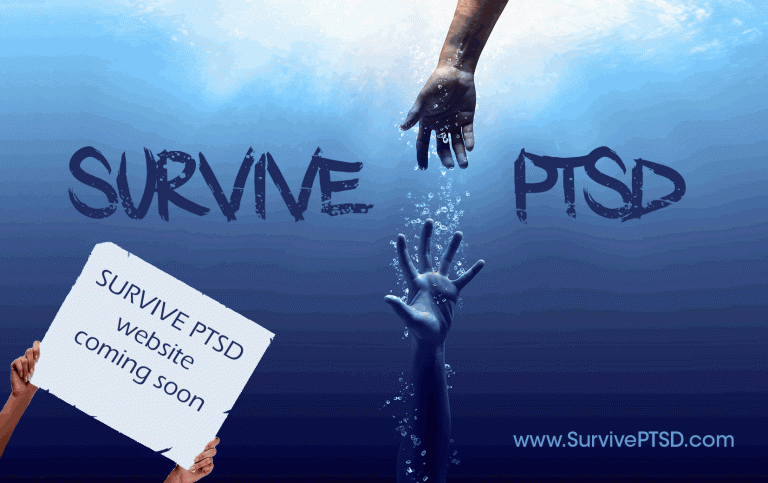
EXCITING TIMES…
New website coming soon. Watch this space for further information

Hypnosis – what it isn’t!
Sorry for the long post but I thought I’d explain what hypnosis is all about in a little more detail.
Hypnotherapy is not about relinquishing control to a mysterious therapist; instead, it’s a collaborative journey between the client and the therapist, working together to achieve positive change and personal growth.
First and foremost, it’s essential to debunk the common misconceptions about hypnosis. Hypnosis is a naturally occurring state of focused attention, similar to daydreaming or getting lost in a captivating book. During a hypnotherapy session, the therapist guides the client into this state to access the subconscious mind, where beliefs, emotions, and habits reside. It’s important to note that the client always remains fully aware of their surroundings and retains complete control over their thoughts and actions.
The heart of hypnotherapy lies in empowering the client. Through the collaborative efforts of the therapist and the client, they explore the client’s goals, challenges, and desires. The therapist serves as a facilitator, providing guidance and using various hypnotic techniques to help the client tap into their inner resources and potential. The client actively participates in the process, and their willingness to engage is crucial for the success of the therapy.
In this collaborative journey, the client’s comfort and trust are paramount. The therapist creates a safe and non-judgmental environment, allowing the client to open up and explore their subconscious with confidence. Together, they work towards reshaping negative thought patterns, overcoming limiting beliefs, and instilling positive affirmations, all aimed at achieving the client’s desired outcomes.
Perhaps the most significant advantage of collaborative hypnotherapy is that it promotes self-empowerment. As clients actively participate in their transformation, they become the drivers of their own change. The therapist acts as a supportive guide, but the client is the ultimate architect of their growth and development. This process often leads to more profound and lasting change, as it emerges from within the client, aligning with their authentic self.
Hypnotherapy is not a mystical, mind-controlling practice but a respectful collaboration between the client and the therapist. Together, they explore the untapped potential of the subconscious mind, unleashing its power for positive change. As this understanding continues to spread, more people are embracing hypnotherapy as a valuable tool for personal growth, self-discovery, and transformation.
So, if you’re curious about the power of your mind and the possibilities that lie within, consider embarking on this fascinating collaborative journey called hypnotherapy. The results might just astonish you!
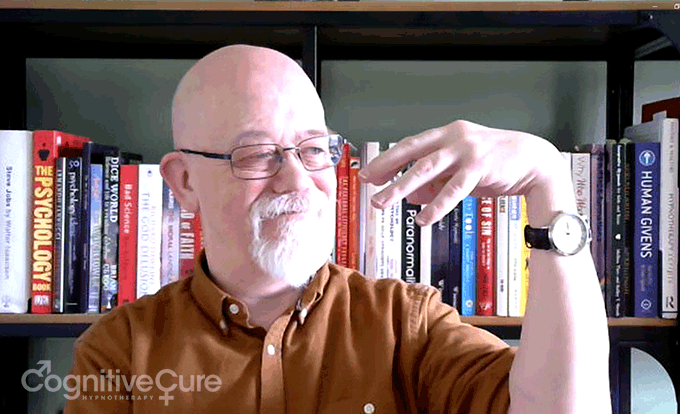
BIRD BRAINED THERAPY
There is no doubt that hypnotherapy is a fast and effective tool for change. It is normal to begin the hypnotic ptocess with an induction. This is where the hypnotherapist will help the client to achieve a deeply relaxed state where they are more open to suggestion. It is in this state that the therapist can engage with the subconscious part of the mind. However hypnotic induction isn’t always appropriate. It’s also true that a small percentage of clients find it difficult to achieve the required level of relaxation.
The good news is that there are alternative ways to engage with the subconscious mind that do not require an hypnotic induction. One of my go-to approaches makes use of The Swan Protocol. The Swan Protocol was developed by my good friend and fellow therapist Bob Burns. In brief the protocol involves the client resting their hand and arm loosly in a position that resembles a swan’s head and neck (hence the name)***. The subconscious is encouraged to communicate with the therapist using a series of identifieable muscle twitches in the fingers and wrist controlled by the subconscious.
Once communication has been established, behavioural changes can be made very rapidly and at a deeply subconscious level. In some cases the subconscious can be invited to take control of the client’s voice and actually speak with the therapist in real time which is quite astounding.
#hypnosis #hypnotherapy #hypnotherapist #induction #subconscious
***Photograph of me in my online therapy room with The Swan

Sex and the City (and more frequently, the therapy room)
Erectile dysfunction (ED) and premature ejaculation (PE) are common sexual disorders that affect a significant number of males. ED is characterized by the inability to achieve or maintain an erection, while PE refers to the inability to delay ejaculation during sexual activity. Both conditions can be associated with performance anxiety, which is a psychological state of fear or worry about sexual performance. Performance anxiety can create a vicious cycle, where the fear of experiencing ED or PE further exacerbates the problem, leading to more anxiety and worsening sexual function.
Hypnotherapy has shown promise in addressing the root cause of performance anxiety and improving ED and PE in males. Through hypnosis, individuals can access their subconscious mind and explore the underlying factors contributing to their anxiety, such as past experiences, negative beliefs, or self-doubt. By identifying and addressing these deep-seated issues, hypnotherapy can help alleviate performance anxiety, increase self-confidence, and promote a more relaxed state of mind during sexual encounters. By breaking the cycle of anxiety and improving overall psychological well-being, hypnotherapy can have a positive impact on sexual performance and satisfaction in males dealing with ED and PE.
#help #mentalhealth #sexualhealth #prematureejaculation #erectiledysfunction #hypnotherapy #hypnotherapist
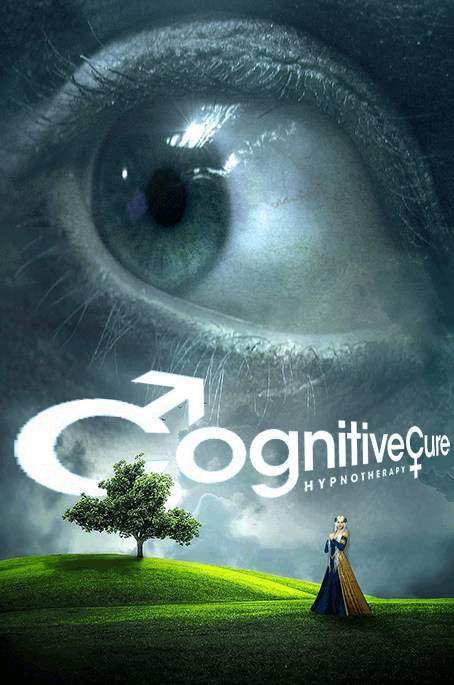
PICTURE THIS…
A metaphor is a figure of speech that involves making a comparison between two seemingly unrelated things to create a symbolic representation. It involves using one concept or object to represent another, helping to convey abstract ideas or emotions in a more vivid and relatable manner. Metaphors often rely on the listener’s or reader’s ability to draw connections between the two elements, engaging their imagination and facilitating a deeper understanding of the subject being discussed. By drawing parallels between different concepts, metaphors can evoke strong emotions, enhance the impact of a message, and provide fresh insights into complex topics.
In the context of hypnotherapy, metaphors are used as a powerful means of communication with the subconscious mind. The subconscious mind is the seat of our emotions, memories, beliefs, and automatic behaviors. It operates on a symbolic, non-linear level, making it receptive to metaphoric language. When a hypnotherapist uses metaphors in a session, they can speak directly to the subconscious, bypassing the analytical and critical conscious mind. Metaphors allow the therapist to present therapeutic suggestions or ideas in a way that the subconscious mind can understand and integrate more easily. This can lead to transformative change, as the subconscious absorbs the metaphor’s meaning and applies it to the individual’s thoughts, emotions, and behaviors on a deeper level.
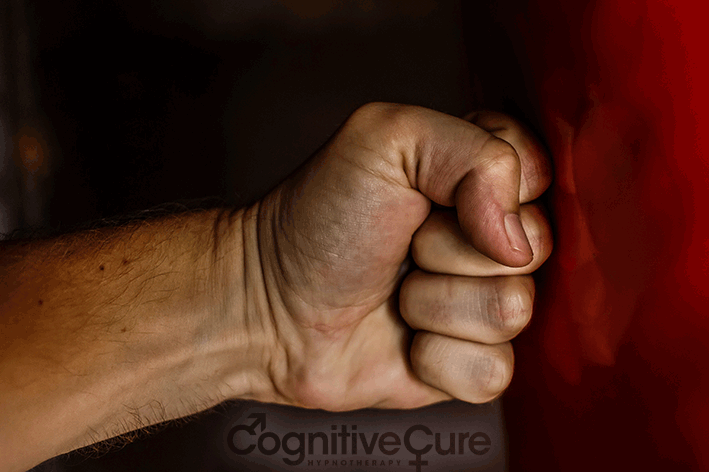
A STRESSFUL DISORDER
Over the last 12 months I have noticed a significant increase in the number of clients seeking help with PTSD.
Post-Traumatic Stress Disorder (PTSD) is a collection of symptoms that individuals experience as a reaction to one or multiple traumatic events. While it is labelled as a disorder, it is important to understand that PTSD is not a personal flaw or something inherently wrong with the individual. The subconscious mind can repress memories of the traumatic event(s), leading to psychological triggers and physical reactions without a clear context or understanding.
Clinical hypnotherapy has proven effective in addressing PTSD symptoms on various levels. Through techniques like hypnoanalysis, the root causes of physical reactions can be identified and treated. This approach has a history of success, with World War II military psychiatrists and psychologists using clinical hypnotherapy to help veterans eliminate physical conditions resulting from their wartime experiences. These techniques have since been used to support veterans from subsequent conflicts as well as individuals outside of the military, such as first responders, healthcare workers, journalists, and victims of violent crimes or abuse.
Symptoms of PTSD can include upsetting memories, nightmares, emotional detachment, irritability, hyper-vigilance, guilt, and loss of interest in activities. Clinical hypnotherapy addresses these symptoms on a subconscious level, providing relief without relying on addictive medications and often yielding faster results than traditional talking therapies. Many individuals experience improvement in their symptoms from the first hypnotherapy session, with complete elimination possible within a few weeks.
If you think you may be suffering with PTSD please do not hesitate to get in touch.

SUGAR COATED THERAPY
Research suggests that consuming sugar activates the brain’s reward system, leading to a surge in dopamine—a neurotransmitter associated with pleasure and motivation. This creates a cycle of craving and reward, similar to other addictive substances. Over time, excessive sugar intake can have detrimental effects on both physical and mental health, including obesity, diabetes, and mood disorders.
Hypnotherapy is a therapeutic technique that harnesses the power of the subconscious mind to facilitate positive changes in behaviour and thought patterns. It aims to induce a state of deep relaxation and heightened focus, known as a trance, wherein the mind becomes more open to suggestions. By guiding individuals through this state, hypnotherapists can help them overcome limiting beliefs, address underlying issues, and break free from destructive habits like sugar addiction.
An essential aspect of hypnotherapy for sugar addiction is altering the perception of sugar itself. Through suggestion and visualization techniques, a hypnotherapist can help you view sugary foods in a less appealing light, diminishing the cravings and reducing the desire to indulge. This shift in perception allows you to regain control over your choices and make decisions that are more mindful when it comes to your dietary habits. Images of a confident, fit and healthy client in the future can motivate and encourage the client to stay on course.

SUBCONSCIOUS SLEUTH
When a client seeks the assistance of a hypnotherapist, the first step in the process involves gathering as much information as possible. This crucial step enables the hypnotherapist to gain insights into the client’s background, experiences, and any traumatic events that may have contributed to the unwanted behaviour. By creating a safe and supportive environment, the therapist encourages the client to share their story.
Successful hypnotherapy aims to treat the issue at its source rather than merely addressing the surface-level symptoms. This is where the hypnotherapist’s detective skills and groundwork come into play. Using various therapeutic techniques and hypnotic tools, the therapist guides the client into a state of deep relaxation and heightened suggestibility, allowing access to the subconscious mind where deep lasting change can be made.
As the hypnotic detective uncovers the root cause behind the unwanted behaviour, the therapist helps the client confront and reframe their experiences. By facilitating the release of negative emotions, fostering forgiveness and acceptance, and introducing empowering suggestions, the therapist assists the client in rewriting their internal narrative. Through this transformative process, individuals can shed the shackles of the past and embrace a new and positive way of being.

TAKE PRIDE
I am proud to run an LGBTQ+ friendly hypnotherapy business, committed to providing a safe and inclusive space for individuals of all sexual orientations and gender identities. As we celebrate Pride Month, Cognitive Cure Hypnotherapy would like to express its unwavering support and solidarity with the LGBTQ+ community.
I believe in the power of self-acceptance, mental well-being, and embracing diversity. Cognitive Cure Hypnotherapy is here to provide compassionate support and help you navigate through any challenges you may be facing. Remember, you are valid, loved, and deserving of happiness. Let’s celebrate love, equality, and individuality together this Pride Month! ![]()
![]()
![]()
![]()
![]()
![]()
![]()

UNLIMITED THOUGHTS
As Mental Health Awareness Month comes to an end, it’s important to shed light on the power of hypnotherapy in unlocking limiting beliefs. Hypnotherapy offers a unique approach to accessing the subconscious mind, where deep-seated beliefs reside. By inducing a state of deep relaxation and heightened focus, a skilled hypnotherapist can guide individuals to explore and challenge their limiting beliefs. Through this process, individuals can gain a deeper understanding of the origins of these beliefs and their impact on their thoughts, emotions, and behaviors.

MOVING FORWARD
For years, hypnotherapy has been met with skepticism and viewed as an alternative or complementary therapy outside the realm of conventional medicine. However, there has been a significant shift in recent times as the medical profession is starting to acknowledge and embrace the potential benefits of hypnotherapy.
One of the key factors contributing to the recognition of hypnotherapy by the medical profession is the increasing evidence supporting its efficacy in various areas of healthcare. Numerous studies have demonstrated the positive impact of hypnotherapy on a range of conditions, including chronic pain management, addiction recovery, anxiety disorders, and irritable bowel syndrome (IBS). Researchers have shown that hypnotherapy can effectively complement conventional medical treatments, leading to improved outcomes and enhanced overall patient well-being. As medical professionals witness these promising results firsthand, they are beginning to appreciate the value that hypnotherapy brings to holistic patient care.
The recognition of hypnotherapy by the medical profession represents a significant milestone in the field of holistic healthcare. The increasing scientific evidence, coupled with the endorsement from professional organizations, is paving the way for hypnotherapy to be embraced as a valuable therapeutic tool. the medical community continues to recognize the potential benefits of hypnotherapy, empowering them to tap into their inner resources and achieve optimal well-being.
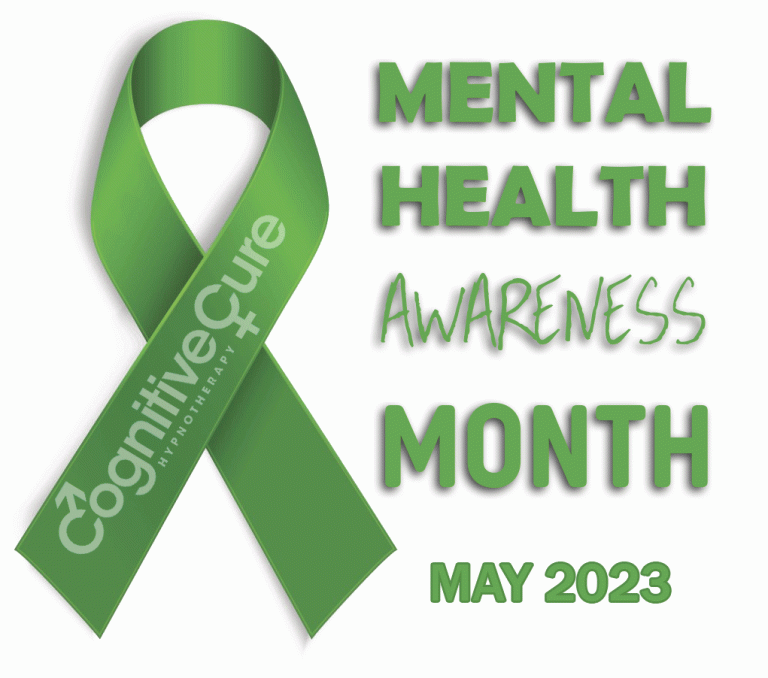
MENTAL HEALTH MONTH
As a hypnotherapist, I am excited to acknowledge Mental Health Month 2023. This is a time to celebrate the importance of mental health and to raise awareness about the issues that many people face. Mental health is an essential aspect of overall wellbeing and it should be treated with the same level of importance as physical health.
In my practice, I have seen the power of hypnotherapy in transforming people’s lives. Hypnotherapy is a therapeutic approach that uses hypnosis to create positive changes in behavior, thoughts, and emotions. It can be an effective treatment for a range of mental health issues including anxiety, depression, phobias, and PTSD.
This Mental Health Month, I encourage everyone to take steps towards improving their mental health. This can include practicing self-care, seeking therapy or counseling, or trying alternative treatments like hypnotherapy. It’s important to remember that mental health is not something to be ashamed of, and seeking help is a sign of strength, not weakness.
In addition to individual efforts, it’s also crucial to advocate for better mental health care policies and resources in our communities. Mental health should be a priority at all levels of society, from local to national, and we can all play a part in making that a reality.
Let’s use this Mental Health Month as a reminder to prioritize our mental health and to support those around us who may be struggling. Together, we can create a world where mental health is recognized and treated with the care and respect it deserves.

AND SLEEP…
Many clients ask me, “What happens if I fall asleep during the session?”.
A few days ago I had a client who got nice and comfortable just before the hypnosis began. Within a matter of minutes he was snoring away loudly as I spoke to his subconscious. I took his subconscious on a long journey full of metaphors and images. the session lasted close to an hour. At the end, I counted him up and back into the room. I asked him how long did he think the session had lasted. He estimated around 10 minutes. I asked him to look at his watch. He was surprised to find almost an hour had gone by.
I don’t worry if the client falls asleep. The subconscious is always listening. The client may well be asleep but when I begin the ‘enduction’ – the count back out of hypnosis, the client almost always wakes up right on cue, indicating that the subconscious had been listening to my every word.
Some clients worry about what would happen if they were left in trance. I carry out almost all of my sessions over Zoom. Clients frequently ask me what would happen if the signal was lost and they were left in trance. So far this has never happened to me. Only on two moccasions have I completely lost the signal. Both times i was able to reconnect to the client and pick up where I left off. On both occasions the client was blissfully unaware of what had happened. If in the event I could not reconnect the client would simply wake up in their own time. Their unconscious part of the mind would be aware of the silence from the therapist and bring the client back to consciousness naturally.
So if i tell you to sleep. yes you can sleep. See less

JOB SATISFACTION
Sometimes words speak louder than actions. This is a recent email from a happy client.
This is why I do what I do…

DON’T USE THAT TONE WITH ME…
After a hypnosis session with a client recently, she confessed that as soon as I had lowered my voice she could feel herself drifting into trance only moments after I had begun.
She had unintentionally created a subconscious association between trance and my hypnotic voice. In NLP terms this is called an ‘Anchor’.
The human voice has long been a powerful tool in the practice of hypnosis. I drop into lower, slower voice tones instictively as I begin the hypnotic induction. The hypnotic voice, with its distinct tone, rhythm, and cadence, is used to induce a trance-like state in the listener, allowing them to become more receptive to suggestions and commands.
My hypnotic voice, like most is slow, steady, and soothing, with a calming effect on the listener. I also use a variety of techniques to enhance the hypnotic voice, such as using pauses and inflections to emphasize certain words, or using repetition to reinforce key ideas.
One of the most important aspects of the hypnotic voice is its ability to bypass the Critical Faculty, the critical thinking part of the brain and speak directly to the subconscious mind. This is why the hypnotic voice is used in therapeutic settings.
While the hypnotic voice can be a powerful tool, it is important to remember that it is not a magic bullet. The listener must be willing and open to the suggestions being made in order for hypnosis to be effective.

ALWAYS LISTENING
Utter the words “Hey Siri…” or “Alexa…” and your related piece of tech will spring to life and respond, letting you know it is here for you. It’s always listening.
As a therapist I spend a lot of time talking to clients. This can be casual conversation; it might be that I am asking questions relating to their issue or it perhaps during hypnosis. One thing is certain the client’s subconscious is always listening. If I am talking to the client about their phobia, I know that the part of their subconscious responsible for that phobia is listening intently to every word I say. Although I might be talking to my client at a conscious level I must choose my words very carefully because that part of the subconscious is listening too.
Later in the session, during hypnosis, I will want to engage with that part of the client’s subconscious. It is vital that I strike up good rapport with that part. And so, during my chat with the client, I am careful that I do not say anything that might insult, annoy or anger that part of the subconscious; in fact I use the client pre-talk to actively praise that part of the subconscious prior to hypnosis. During the chat with the client, I might say something like this;
“…You know your phobia is caused by a part of your subconscious mind. That part is running a protective behaviour to keep you safe and that part is doing an amazing job. It has learned from a previous experience and works relentlessly to make sure you never experience something like that ever again, it truly has the best intentions for you…”
I know that the ‘part’ responsible for the client’s phobic behaviour will be listening and will appreciate the acknowledgement of all its hard work. When I begin the hypnosis there’s already a better chance that it will be willing to engage with me.
Next time you talk to someone, consider your words, you never know who else is listening.
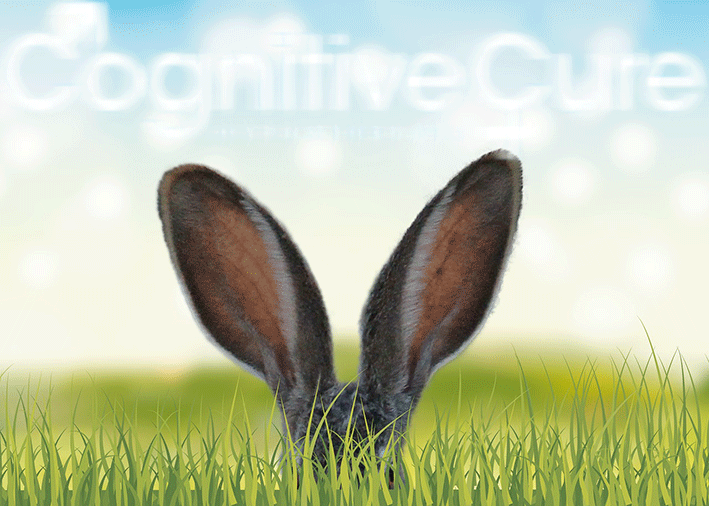
EASTER ESCAPE
No clients this weekend but it all starts again with two new clients on Monday. One client with CPTSD and another with anorgasmia. My job is varied, challenging and never dull…
HAPPY EASTER EVERYONE ❤️
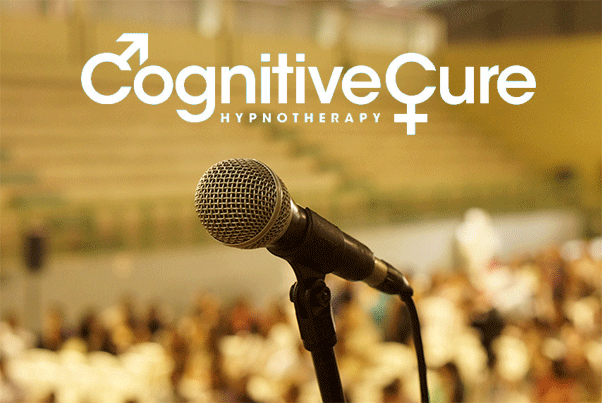
GETTING INTO THE HABIT
On Friday I had the privilige to talk to 12-13 year olds at a local school. The school was holding a ‘Disconnect Day’ where the pupils were having a day of fun away from their smartphones. I taught the students a very simple method for breaking a habit, almost any habit. The simple protocol actually employs a number of different principles founded in psychology, NLP and hypnosis. Both the teachers and students found it really interesting.

THE DEVIL IS IN THE DETAIL
As a therapist it is important to gather as much information from the client as possible. The more the client tells you, the better picture you have of them. For that to happen it is essential to buid good rapport with the client. This should come naturally. The client should be able to sense that you are genuinelyy interested in them – and let’s face it if you’re a therapist you should be.
I am fortunate in that respect; I am also a freelance body language analyst and work for mainstream media. I am frequently called upon to analyse the body langugae of VIPs and celebrities for magazine and newspaper articles as well as for radio and television. I even wrote a book on the subject back in 2012.
When a client visits me I listen carefully to what thay have to say, and how they say it – what words they use to express themselves. I also observe their body language. Body language and tone of voice – not words – are our most powerful assessment tools, the Devil is in the detail.

IT’S THE WEEKEND…BUT WAIT
It’s the weekend but here I am recording and editing audio files for clients to listen to between sessions. After dinner I writing up client notes from previous sessions. On Sunday I have to catch up with my online college coursework and prepare my talk for a school visit at the end of the month. Oh, and this that you’re reading right now…

BACK TO SCHOOL
Around this time last month I was delivering a talk about stress and anxiety to teaching staff at a local secondary school (13-18 yr olds). I was recently invited back to speak to a larger group during an in-service day. Well, they want me back again, this time to speak to senior students prior to their exams. I’ll be sharing breathing exercises and ways to combat stress and anxiety.

AT WAR WITH PTSD
Post Traumatic Stress Disorder doesn’t just affect the millitary and it doesn’t just affect the emergency services. A tramatic experience can have a profound effect on anyone. You needn’t suffer in silence. A six session hypnotherapy program can help resolve those deep subconscious emotions and behaviours.
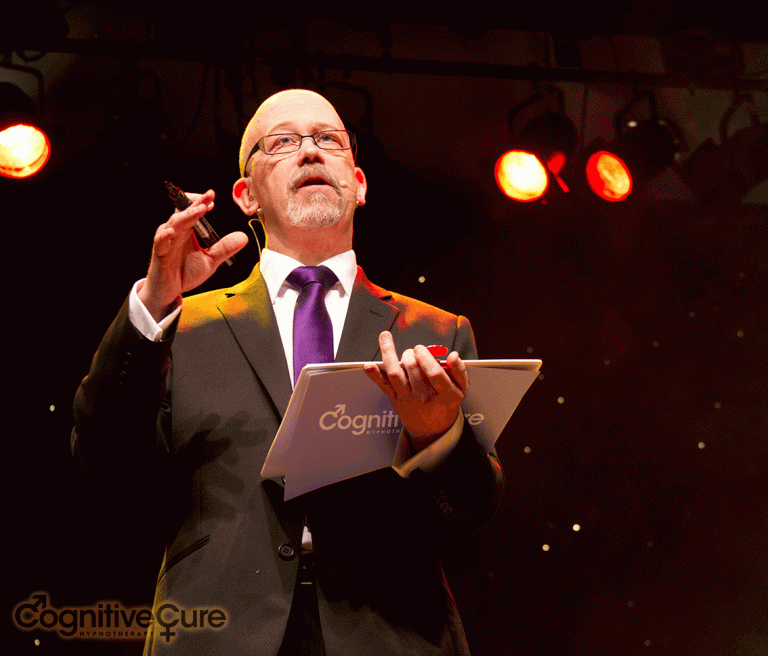
A FIGURE OF SPEECH
That’s a photo of me speaking at a conference. I’m quite comfortable speaking in public but it wasn’t always that way.
Speaking in public is one of the most common fears. This fear doesn’t just affect company CEOs who have to present at a conference. It can affect us all whether you’re the father of the bride at a wedding or you’re making your views heard at a local community meeting. Most often this is actually a fear of criticism and sadly the biggest critic is ourself. Thankfully hypnotherapists have a large array of approaches to combat Glossophobia, some involve hypnosis but many don’t.
What’s your biggest fear? I bet it’s more common than you think.
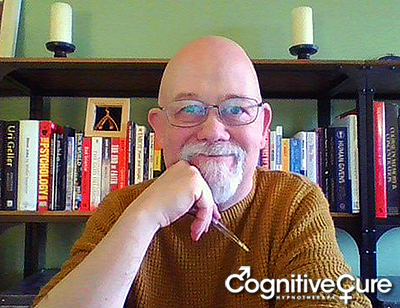
EVERY DAY IS A SCHOOL DAY
It’s the weekend but I’m studying for my Level 2 Self Harm and Suicide Prevention Certification. I’m also attending a course on dealing with PTSD. The learning never ends 🙂

I DID IT MY WAY
The solution to any issue comes from the client. The solution is found deep within the unconscious mind. It truly is a Cognitive Cure (see what I did there, eh!) It is the role of the hypmotherapist to guide the unconscious to the solution.
I had a client recently who had Cynophobia, an intense fear of dogs. I discovered that she had a traumatic experience with a dog at the age of 6. The client had no conscious recollection of this until hypnosis. After the first session I was confident that the client had conquered her phobia and that over the next few days her unconscious would install all the necessary changes to her behaviour. I had suggested we pencil another session in the diary in case further work was necessary. Four days later the client emailed me. She thanked me for my time but confessed she had managed to overcome her fear all by herself. She told me that her neighbour had just got a new dog and she had decided there and then that she was no longer going to be controlled by her fear and go round and meet the dog. She told me that she had gone round to the neighbour and had petted the dog and had fed the dog treats from her hand. She proudly informed me that she would not need the second session as she had “…fixed it all by myself…”
I smiled to myself and congratulated her.
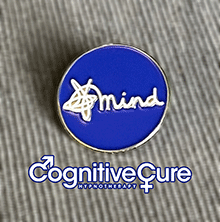
TIME TO TALK
I’ve been invited to speak to teachers at a local school about stress management later this month. I’ll also be demonstrating some simple and discreet techniques they can use to manage stress.
I support the mental health charity ‘MIND’ and this enamel pin badge has arrived today, in time to wear at my talk.

ANXIETY – IT’S JUST A THOUGHT
I would never trivialise anxiety but in general anxiety is born from the dreaded ‘What if…’ whether it’s about the past or anticipation of the future. We become anxious when our thoughts become confused with reality inside our heads. Things to remember…
– Your thoughts aren’t reality
– If you’re having the thought then it’s not happening at that moment.
– Thoughts don’t dictate your destiny
– Thoughts, they’re just thoughts.